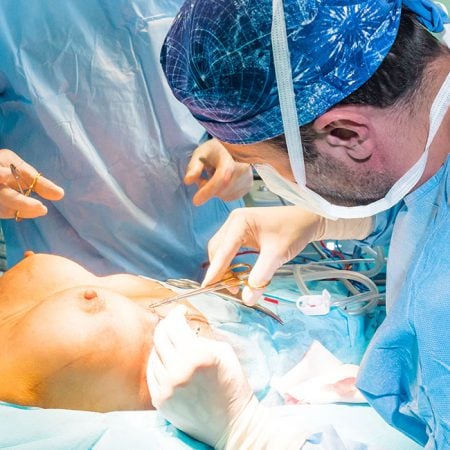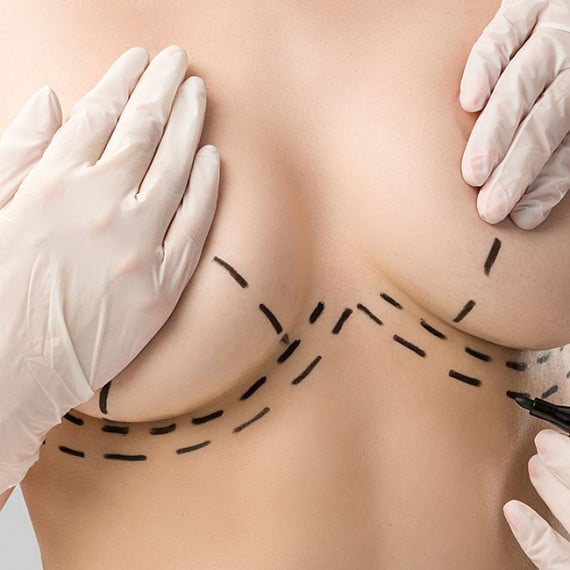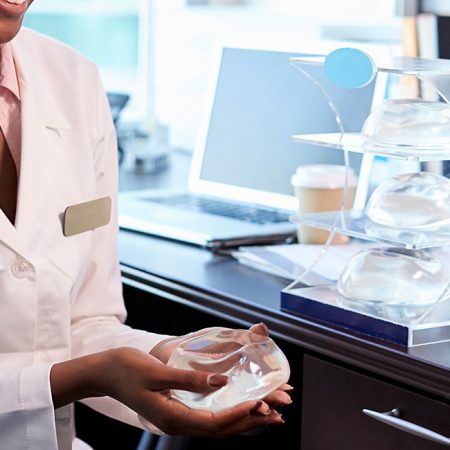Dr. Pasquale has spent more than 25 years analyzing and correcting patients with failed breast reconstructions, bad breast augmentations, capsular contractures and uneven breast lifts. There are various reasons why a woman may seek to have further surgery. We at the infinity life center have one of the worlds experts in breast augmentation revisions, having fixed problems with age related changes, other problematic surgeries and unexpected results. Breast augmentation is a very common surgery and thus some complications arise. It’s not too much to expect your breasts to be symmetrical, free of rippling, without capsular contracture, reasonably shaped and attractive.
Breast Revision Surgery Specialist
Dr. Michael has superior experience and training in breast revision and reconstruction. He has lectured and taught courses abroad for many years sharing this knowledge and experience. He understands the tragedy of a good operation turned into a nightmare. The plastic and reconstructive surgeons of Infinity Life Center can help you with most any problem you have with your present breast augmentation which has gone bad. We have years of experience behind us and good judgment. There is no need to suffer or be unhappy with your augmentation result.
Reasons for Breast Revision Surgery
There are many reasons why a women would want or require a breast revision. In some instances the woman may just be unhappy with the implant size she has chosen and wants to go bigger or smaller. Some patients switch from saline implants to the more expensive gel or silicone implants for a softer more natural looking breast. Some complications occur through no fault of the surgeon, some happen based purely on the anatomy of the patient with no way of knowing the outcome before hand. Below are the risks and complications that can occur to breast augmentation or breast enhancement patients. The risk of any of these risks or complications occurring to you are quite low, but they do happen.
Common Problems & Complications Related to Breast Augmentation
- Breast is Too Large or Small
- Capsular contracture
- Hematoma
- Seroma
- Necrosis
- Symmastia
- Botomming Out
- Ruptured Out
- Ruptured or Deflated Implant
- Double Bubble
- Infection
- Loss of Sensation
Do You Need a Breast Revision?
Most women can tell a subtle change in their body or shape while others notice nothing at all. There are tests, such as a mammogram, MRI or ultrasound that can help to determine if there is a problem with your breast implants, but ultimately the best determination is made by an experienced plastic surgeon. A plastic surgeon who has seen most if not all the problems and complications that occur with breast implants will be able to not only tell you what problems you are having but the solutions that will be needed to correct them.
There are several reasons why patients may need a breast revision. Uneven, asymmetrical or misshapen breasts are the basic reasons why patients opt for a revision. We offer many different breast revision surgeries to correct specific problems that occur in regards to breast augmentation, breast lift, breast reduction or breast cancer reconstruction. Some patients may unfortunately require multiple surgeries to correct certain problems. Infinity Life Center has some of the nations foremost breast specialists and experts in reconstruction.
Each case is different and each case must be evaluated on an individual basis. Our surgeons will give you the time you need and all effort to make your breast revision surgery obtain the results you desire. That is our promise and that is what makes our center different in so many ways.
Breast Implant Rupture – Saline or Silicone
Breast implant rupture, deflation or leakage is a common reason why women may need breast revision surgery. The devices, whether saline or silicone, may leak and the woman may notice that one or both of her breasts has changed shape or size. You may actually know how and why the breast implant has been ruptured, or it may just begin to feel different.
Cost of Surgery to Replace Ruptured Breast Implants
Depending on the reason for the breast implant rupture, the breast implant may be covered under warranty. If the implant is covered, the patient won’t receive a refund until the implant is removed and sent to the manufacturer for inspection. If the implant is deemed to Surgery to fix a ruptured implant can be a simple painless procedure which can oftentimes be done under local/sedation eliminating the cost for general anesthesia.
A ruptured or deflated implant is covered by the product warranty in some instances. Breast implants that are damaged by a closed capsulotomy or during the breast augmentation surgery are not covered by the warranty. You can research the breast implant warranty for Mentor Breast Implants Warranty Info, or Allergan Breast Implants Warranty Info.
SALINE BREAST DEFLATION
Saline implants are for the most part easily diagnosed as ruptured or not. Whether the implant has a pinhole, a tear, or an abrasion, the saline will eventually leak out entirely. At that point, one can usually see the deflation clearly, and the resultant smaller, flat, deflated breast in comparison to the other.
SILICONE (GEL) BREAST DEFLATION
Its a different case altogether with a leaking silicone implant this may not be noticed as quickly or easily. In most instances, the silicone gel is of the new cohesive type and will not leak out of the implant. The implant may become slightly misshapen, but many times this is unnoticeable. The silicon gel may be contained within the capsule formed around the breast if it does in fact leak, which is rare. Most silicone or gel implants that rupture require MRI imaging or visual inspection after surgical implant removal to be able to determine if the implant is indeed ruptured.
Remove and Replace Surgery for Breast Implants
Remove and Replace of breast implants can be a relatively simple and painless procedure performed oftentimes under local anesthetic with sedation as opposed to full general anesthesia. The reason for this is that in most cases the patient already has a well dissected breast pocket in which to place the implant. In cases where the patient is going with an either much larger or smaller implant than they currently have, they will need to have their breast pocket adjusted to allow for the different size breast implant.
Increase or Decrease Breast Implant Size
Surgery to make breast implants bigger or smaller can be a simple and painless procedure by either adding or removing saline or replacing the old implants with bigger breast implants. Women who aren’t satisfied with the size of their implants may choose to go smaller or larger in size. With saline implants the surgeon can remove or add fluid to change the size of the implant. This is usually only meant to be used as a minor adjustment with regards to small differences in size from one breast to the other (asymmetry). By adding or subtracting small amounts of fluid you can achieve better symmetry or balance in size with the breasts. To change the size of the implant any more than 20-30cc (approx) would require purchasing new implants. With saline breast implants there is a limit that you can underfill or overfill the implant according to manufacturer specifications. With silicone or gel implants the fill volume is permanent, so a new implant would be required.
Underfilling Breast Implants
Some surgeons choose to underfill the implant for a softer more natural looking breast. This can sometimes result in a sloshing feeling with the implant as well as it increases the chance of folds with the implant that can cause rippling, constant rubbing and potential rupture. Underfilling beyond the manufacturer specifications is usually not recommended and can void the warranty of the implant.
Overfilling Breast Implants
Overfilling the breast implants usually results in less rippling and/or folding of the implant which can be visible on the surface of the breast. Overfilling also produces a longer lasting implant because wrinkling of the breast implant is one of the leading causes of failure or rupture of the product. Overfilling beyond the manufacturer specifications is usually not recommended and can void the warranty of the implant.
Symmastia or Uniboob Breast Implants
The breasts appear too close at the center and the implants can appear to be touching each other. Symmastia (aka – uniboob, breadloafing) occurs only when an implant is placed under the muscle (submuscular) and the pectoralis muscle is severed from the sternum.
When breast implants are placed submuscularly (under the muscle), there is a possibility that the pectoralis muscle will be cut, allowing breast tissue and the breast implants to fall towards the sternum at the center of the chest. This happens when the breast pocket is overly dissected towards the center and releases the pectoralis muscle too much resulting in the implants laying too close to center with unnatural looking cleavage and a uniboob, or “bread-loafing” effect.
This is detected usually a few days after surgery as the post-operative swelling of the breasts lifts the breast tissu, letting the implants slide towards the cleavage area. This problem is usually difficult to detect during or immeadiately after surgery.
Surgery to Repair Symmastia
There are many techniques to correct or repair “uniboob” or symmastia. The correct repair uses internal sutures to reattach and reinforce the cleavage area from the breast implants. It is absolutely imperative that you take the time to find and evaluate the right plastic surgeon for your breast revision surgery.
Bottoming Out Breast Implants
Bottoming Out of Breast Implants refers to the loss of the inframammary crease in the patients lower breast implant pocket. The breast look abnormally low with the nipple pointing upward. The inframammary crease sometimes is released too much by the surgeon or it can happen naturally. This will depend on the anatomy of the patient.
How Does Bottoming Out of Breast Implants Occur?
In other words, over-dissection or opening up of the pocket can cause many of the complications related to breast augmentation surgery. Bottoming out of the breast implants is another one of these occurrences. Bottoming out can also happen as a result of the patients own anatomy and at no fault of the plastic surgeon at all. Some patients have very thin breast tissue and an implant which is heavy enough can pull the breast downward causing it to bottom out. With bottomed out breast implants the high point of the breast (also known as the breast mound apex) appears too low and the nipples too high. There is also an unnatural breast crease (inframammary breast fold) which is too low on the chest. Bottoming out has a higher occurrence therefore in patients who have subglandular breast implant placement as opposed to submuscular or partial submuscular. This is because the skin is providing the majority of the support for the implant, rather than the muscle and underlying breast tissue if the implant was submuscular.
Correction of Bottoming Out Breast Deformity
Reinforcement of the breast crease (inframammary fold) with internal sutures is one of the potential corrective surgeries for bottomed out breast implants. There are other techniques which can be used such as the use of certain materials to hold the pocket up. Dr. Pasquale has corrected this deformity with a non-surgical technique where he uses the patients on blood.
Double Bubble Breast
Usually the solution for a double bubble in regards to breast implants is a breast lift or re-placement of the breast implants to subglandular or above the muscle. Double bubble is the term used for a patient who has undergone breast implant surgery and the results are larger breasts that have a second bump (bubble) at the inframammary fold (breast crease). This is usually caused by breast ptosis (sagging breasts). Sagging breasts require a mastopexy (breast lift) to surgically repair the breasts. A breast lift with breast augmentation surgery performed all at once has very positive results for patients who need both.
Double bubble complications normally occur when the implant is placed below the pectoral muscle (submuscular) and may happen after several years of gradual stretching of the inframammary crease. This oftentimes is the case with implants that are placed through an incision at the inframammary fold. This creates trauma to the natural crease creating a lower bulge and an upper bulge from the breast tissue.
Surgery to Repair Double Bubble Breast Implants
Most well trained and experienced plastic surgeons will be able to determine that a patient will be at risk for double bubble before the surgery. In this case the surgeon will usually suggest a breast lift to correct the sagging inaddition to the breast augmentation. The breast implant can also be placed subglandular to eliminate more risk.
Sometimes there are factors that increase the risk post operatively such as: pregnancy, breast feeding, weight loss and aging. In these situations the appropriate repair is either a breast lift to correct the sagging breast tissue, larger implants, changing the placement of the implants, or possibly an inframammary fold revision.
Finding a Surgeon for Breast Revision Surgery
Many surgeons (plastic or cosmetic) are reluctant to admit that they do not know what problem you are having, offering a flawed diagnosis based on their limited experience or training. This would obviously result in an erroneous plan to correct the misdiagnosis, leaving you with the same problem or worse. You would also have paid to have a meaningless surgery in addition to the pain and discomfort (mental and physical) that goes along with any surgery.
Find a Board Certified Plastic Surgeon for Breast Revision Surgery
Many of the best plastic surgeons to consult with for these problems are board certified in reconstructive surgery. Others have specialized in breast reconstruction for cancer patients and breast augmentation specifically. Whomever surgeon you should choose should have the ability to perform breast augmentation through numerous approaches (periareolar, axillary, inframammary, perithelial), they should have a lot of before and after pictures of breast implant patients (10 or more years of experience with breast implant surgery), and they should be a board certified plastic surgeon. It also helps to get several opinions in regards to the cause of your particular problem and which course of action can or should be taken to correct it.






